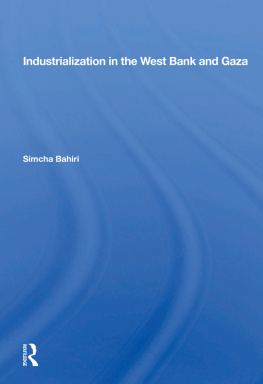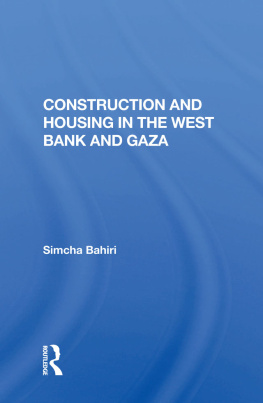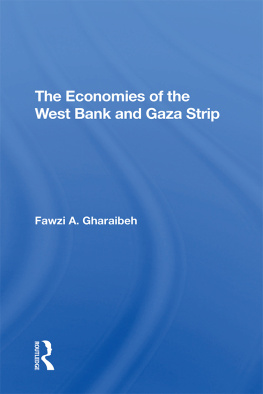WBDP The West Bank Data Base Project
Industrialization in the West Bank and Gaza
by
Simcha Bahiri
Research Report
First published 1987 by Westview Press
Published 2018 by Routledge
52 Vanderbilt Avenue, New York, NY 10017
2 Park Square, Milton Park, Abingdon, Oxon OX14 4RN
Routledge is an imprint of the Taylor & Francis Group, an informa business
Copyright 1987 by Taylor & Francis
All rights reserved. No part of this book may be reprinted or reproduced or utilised in any form or by any electronic, mechanical, or other means, now known or hereafter invented, including photocopying and recording, or in any information storage or retrieval system, without permission in writing from the publishers.
Notice:
Product or corporate names may be trademarks or registered trademarks, and are used only for identification and explanation without intent to infringe.
The research for this report was partially carried out in the framework of the Israel Institute of Business Research, University of Tel Aviv.
The views expressed in this publication are those of the author and do not necessarily reflect the views of the staff or editors of The Jerusalem Post.
ISBN 13: 978-0-367-00569-6 (hbk)
Abstract
The West Bank and Gaza Strip, occupied by Israel since 1967, have stagnated in the number employed (some 17,000) in domestic industry for 20 years and in the percentage contribution (8.5 per cent) to the gross domestic product. Their 4,000 establishments are mostly workshops employing on average just over four workers. Food and textiles are the dominant industries and there is much sub-contracting for Israeli firms. Some 90 per cent of industrial imports come from or through Israel and some 70 per cent of their industrial exports go to Israel, with the remainder going to or through Jordan. There are many barriers to the development of industry in the occupied territories but they overwhelmingly have their origin in the occupation itself and to a lesser degree result from difficulties made by Jordan. The Military Government runs the territories to ensure not only military security but also Israel's "economic security."
Three alternative economic scenarios are projected to 1997 based on three possible futures facing the territories: (a) a conservative scenario based on continuing the occupation in its present form (status quo); (b) a reformist scenario in which both Israel and Jordan liberalize their policies within the framework of continued occupation; and (c) a radical scenario in which Israel leaves the territories in return for peace, and a separate Palestinian entity is established. In terms of industrial development the conservative scenario would yield minimal results, the reformist scenario some minor improvements in the "quality of life," and the radical scenario would result in rapid industrial development and settlement of returning refugees.
Table of contents
List of Tables
While the State of Israel since its establishment in 1948 up to the present has reached a relatively high degree of industrial development approaching on a per capita basis, some of the advanced industrialized countries, the remainder of former Mandatory Palestine - e.g. the West Bank (WB) and Gaza Strip (GS) - have stagnated industrially. This has been the situation both under Arab occupation (Jordanian - WB, or Egyptian - GS) till 1967, and under Israeli occupation since then.
It is the intention of this study briefly to review past industrial development and the state of existing industry in the West Bank and Gaza Strip and to assess under various political-economic scenarios the potential for industrial development over the coming decade: 1987-97.
There have been several economic reports, especially since 1978, on the industrialization of the West Bank and Gaza Strip - both of the existing situation and past developments; and to a lesser extent projections for the future in the event of the establishment of a Palestinian entity., 1981) involved independent field work.
The majority of studies have been based on statistical samples compiled by the Israeli Central Bureau of Statistics. As their data deal only with Arab enterprises in the territories, there is some distortion. Despite other contradictions in some of the data (e.g. between the value of production and exports). This study will attempt to deal with other options as well.
The objectives of this work are therefore to:
- Outline the state of industry in the WB/GS based on other published works and statistics (supplemented by numerous plant visits and interviews by the author);
- describe past and existing barriers to and constraints on industrial development and to assess their impact; and
- indicate the growing dependence of the economy of the territories on Israel; and
- to project potential economic development scenarios, especially
industrial, under various possible political-economic options. Finally, it is hoped that publication of this work will provide both Israeli and Palestinian decision-makers with information required to promote industrial development in the territories and "improve their quality of life."
Before we proceed we should point out that as Benvenisti emphasizes: "For statistical purposes the West Bank and Gaza Strip are considered by Israel's Central Bureau of Statistics to be units independent of Israel. Economic activity there is investigated and reported as though it constitutes a 'national economy' united with Israel in a 'common market.' The official reporting of GDP, GNP, exports and imports and balance of payments of the territories is, however, inaccurate at best and misleading at worst. The daily, complex, economic interaction over the nonexistent 'green line' lacking any effective monitoring and control call the reliability of the statistics into question. Moreover, the 'national accounts' of the territories have no territorial basis. The economic activity of the Jewish settlers ... as well as general government expenditure on Jewish residents (in the occupied territories) are all included in Israel's accounts, not the West Bank's (or Gaza's). The accounting borders on the absurd when economic interaction between two adjacent localities, such as Kiryat Arba and Hebron, is regarded as 'international trade'."
Furthermore, when one considers that the last official census of the West Bank and Gaza Strip was conducted in 1967 then the reliability of official economic and population and demographic statistics is further weakened.
As in all research projects a variety of approaches has been used in meeting the objectives of this study.
Broadly these have involved both inductive and deductive methods. They have included an extensive review of relevant literature (see . Note, however, that we will concentrate only on Arab industry in the territories: their actual state and - possibly more relevant here - their potential development.
The central idea in this paper is the generating of alternative economic (and population) projections for 1997, and hence industrial projections. These are based on three different but possible scenarios, namely:
- a continuation of the present situation and occupation, and existing trends in the territories - e.g. no change of policy by either Israel or Jordan, and no major shift in local industrialization efforts, i.e. a conservative scenario;










